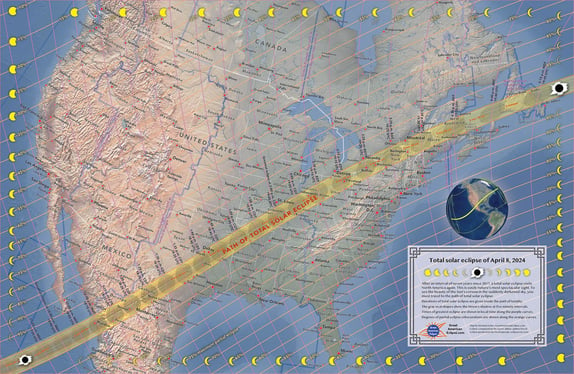From stunning images of the sun collected by the Solar Dynamics Observatory (SDO) to mission milestones for the Parker Solar Probe, there is exciting news to report about the sun–even in the midst of winter! Along with the Solar Orbiter, these two spacecraft are part of NASA’s Living With a Star program (LWS). These missions are meant to collect data that will increase our understanding of solar weather and its effects on our planet.
Solar Dynamic Observatory Mission
The Solar Dynamic Observatory (SDO) was launched on February 11, 2010. This small spacecraft is fitted with an array of four instruments. Together, these instruments provide data at over 100 megabytes per second (Mbps), tracking sunspots, solar flares, and coronal mass ejections (CMEs).
With the 14th anniversary of its launch on the horizon, it might be time to look at what goals of its mission it has accomplished.
According to The Sun Today:
Since its launch on Feb. 11, 2010, SDO has collected millions of scientific images of our nearest star, giving scientists new insights into its workings. SDO’s measurements of the Sun—from the interior to the atmosphere, magnetic field, and energy output—have greatly contributed to our understanding of our closest star. SDO’s images have also become iconic—if you’ve ever seen a close-up of activity on the sun, it was likely from an SDO image.
According to a PDF guide produced by NASA, the goal of the SDO is to track the variations in solar weather that affect the Earth, including its satellites and communications systems. The need for that kind of predictive ability was demonstrated on January 11, 2024, when a solar flare caused a minor radio blackout over French Polynesia in the South Pacific Ocean.
(Image Courtesy of NASA/SDO and the AIA, EVE, and HMI science teams.)
Because SDO takes images of the sun in 10 wavelengths every 10 seconds, the amount of data is enormous. May the images it captures continue to astound, delight, and teach us.
Parker Solar Probe Touches the Sun: Many Firsts Remembered
The Magis Center reported on the mission of the Parker Solar Probe just after its launch in 2018 and then published an update in 2019. This astounding space observatory is the first spacecraft to be named for a living person and is the fastest-moving man-made object. Its speeds range from 153,454 miles per hour to about 430,000 miles per hour. Now, there is more news to add!
On December 14, 2021, three years after its launch, the Probe made history when it literally “touched the sun.” As it flew through the sun’s upper atmosphere, the corona, it collected particles and gathered data on our star’s magnetic fields. In this data, scientists observed what they are now calling switchbacks because the rapid flips in the Sun’s magnetic field looked like switchbacks on a winding mountain road. These switchbacks led scientists to use data from other solar observatories and instruments, leading to discovering a possible source of solar wind.
Data and images collected revealed “jetlets” of plasma in this part of the sun’s atmosphere. These jetlets are only a few hundred miles long, but can add up to create a steady wind. According to Nour Raouafi, the study lead and the Parker Solar Probe project scientist at the Johns Hopkins Applied Physics Laboratory (APL) in Laurel, Maryland:
You can see the flow of the solar wind rising from tiny jets of million-degree plasma all over the base of the corona. These findings will have a huge impact on our understanding of the heating and acceleration of the coronal and solar wind plasma.”
This discovery is helping scientists understand the source of the solar wind, but why would this be important? Aside from creating beautiful auroras, according to NASA:
Made of electrons, protons, and heavier ions, the solar wind courses through the solar system at roughly 1 million miles per hour. When the solar wind interacts with Earth’s magnetic field, it can create stunning auroras as well as disruptions in GPS and communications systems. Over time, the solar wind, and stellar winds in other solar systems, can also affect the composition and evolution of planetary atmospheres—even influencing planets’ habitability.
Closer encounters?
Although Parker “touched the sun” in 2021, it has not come as close to the sun as planned–yet. One of the goals of its mission is to get within 3.9 million miles of the sun. That goal should be reached in December 2024–the end of this year!
NASA continues to collect, analyze, and explore the data from this formidable spacecraft. You can peek at Parker’s contributions in other areas of space science using the NASA links described below:
Each new dataset expands the limits of space science—and it’s not just about the Sun. Parker Solar Probe has also studied comets, detected radio emissions from Venus’ atmosphere, and even captured the first-ever images of Venus’ surface in visible wavelengths.
Last but not least: the Solar Eclipse!
According to NASA, eclipses are a “convenient coincidence.”
On Monday, April 8, 2024, along a 100 mile-wide path through Mexico, the United States and Canada, viewers will see the moon pass directly in front of the sun creating a total solar eclipse.
In other areas, viewers will see a partial eclipse, which is still an exciting event as the sky darkens and the moon’s shadow partially obscures the sun. You can find what your view of the eclipse will be like using the map below from the Great American Eclipse website.
(Image credit: www.greatamericaneclipse.com)
Two planets will also be visible as the moon obscures the sun’s disk: Venus and Jupiter. What makes this eclipse especially interesting to scientists and viewers alike, however, is that, at totality, the sun’s corona is expected to be larger than usual. This is because the sun is close to maximum activity in its solar cycle. Scientists will take this opportunity to collect new data about the sun’s surface.
Although total solar eclipses will occur in other parts of the world in the next ten years, this is the last that will be visible in the United States until August 2044. So grab some solar eclipse glasses (not optional!) and enjoy the show on April 8!

